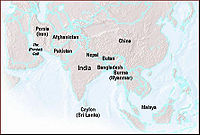HEIC Early Voyages
| HEIC Early Voyages | |
|---|---|

| |
| See our interactive map of 1st HEIC Voyage on Google Maps | |
| HEIC Early Voyages | |
|---|---|

| |
| See our interactive map of 2nd HEIC Voyage on Google Maps | |
History
The early expeditions of the East India Company were called the Separate Voyages as separate capital was raised for each. The object of the expeditions was to establish trade with the spice islands of the East Indies.
First Voyage (1601-03)
Captain James Lancaster was appointed "General" of the fleet and sailed in the 'Red Dragon'. John Middleton was 'Vice-Admiral'. Other ships were the 'Susan', the 'Hector', the 'Ascension' and the 'Guest'. Thefleet captured a Portuguese vessel of the coast of Guinea and took her cargo of wine, oil and meal. After calling at Saldanha at the Cape of Good Hope, Madagascar and Nicobar, they reached Achin where they were able to secure a cargo of pepper. Lancaster established the first factory on at Bantam on the coast of Sumatra. An account of the voyage is given in Letters received by the East India Company Vol I (1602-13).
Second Voyage (1604-06)
Captain Henry Middleton, who had sailed on the first voyage with his brother John, led the expedition in the 'Red Dragon' again with the 'Hector', 'Ascension', and 'Susan'. Arriving at Bantam, the 'Hector' and 'Susan' loaded pepper and set out for home but 'Susan' was lost on the way. The 'Red Dragon' and 'Ascension' proceeded to Amboyna hoping to establish a factory. They were unable to do so however due to opposition from the Dutch. The 'Ascension' then went to Banda while Middleton took the 'Red Dragon' to Ternate and Tidore where trading was permitted and a cargo of pepper obtained. He called at Makian but Dutch objections prevented him from establishing a factory at Ternate though he obtained some cloves. The' Red Dragon' and 'Ascension' set sail for home but became separated en route. Middleton found the 'Hector' at Saldanha and the two ships arrived in England at the same time with 'Ascension' following later. The profit on first two voyages was repoeted as 95% on the capital. An account of the voyage is given in Letters received by the East India Company Vol I (1602-13).